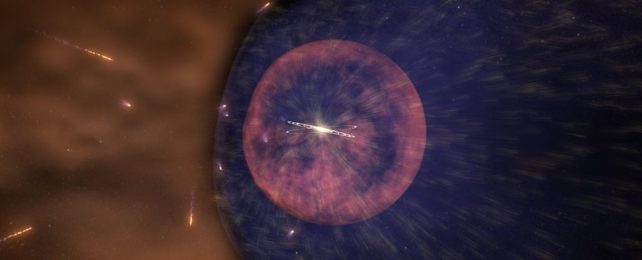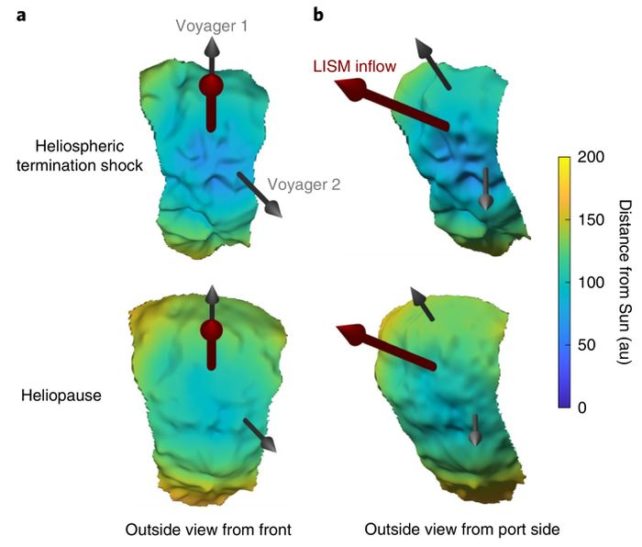 An illustration showing the Solar System inside the heliosphere, with the termination shock and heliopause represented by two bubbles, one inside the other. (NASA)
An illustration showing the Solar System inside the heliosphere, with the termination shock and heliopause represented by two bubbles, one inside the other. (NASA)The bubble of space encasing the Solar System might be wrinkled, at least sometimes.
Data from a spacecraft orbiting Earth has revealed ripple structures in the termination shock and heliopause: shifting regions of space that mark one of the boundaries between the space inside the Solar System, and what's outside – interstellar space.
The results show that it's possible to get a detailed picture of the boundary of the Solar System and how it changes over time.
This information will help scientists better understand a region of space known as the heliosphere, which pushes out from the Sun and shields the planets in our Solar System from cosmic radiation.
There are a variety of ways the Sun affects the space around it. One of those is the solar wind, a constant supersonic flow of ionized plasma. It blows out past the planets and the Kuiper Belt, eventually petering out in the great emptiness between the stars.
The point at which this flow falls below the speed at which sound waves can travel through the diffuse interstallar medium is called the termination shock, and the point at which it is no longer strong enough to push back against the very slight pressure of interstellar space is the heliopause.
Both Voyager probes have crossed the heliopause and are, effectively, now cruising through interstellar space, providing us the first in situ measurements of this shifting boundary. But there's another tool out in Earth orbit that has been helping scientists map the heliopause since it commenced operations in 2009: NASA's Interstellar Boundary Explorer (IBEX).
IBEX measures energized neutral atoms, which are created when the Sun's solar wind collides with the interstellar wind at the Solar System boundary. Some of those atoms are catapulted further out into space, while others are flung back at Earth. Once the strength of the solar wind that produced them is taken into account, energized neutral particles that return our way can be used to map the shape of the boundary, a bit like cosmic echolocation.
Previous maps of the structure of the heliosphere have relied on long-scale measures of the evolution of solar wind pressure and energetic neutral atom emissions, which resulted in a smoothing of the boundary in both space and time. But in 2014, over a period of roughly six months, the dynamic pressure of the solar wind increased by roughly 50 percent.
A team of scientists led by astrophysicist Eric Zirnstein of Princeton University has used this shorter-scale event to obtain a more detailed snapshot of the shape of the termination shock and heliopause – and found huge ripples, on the scale of tens of astronomical units (one astronomical unit is the average distance between Earth and the Sun).

They also performed modeling and simulations to determine how this high-pressure wind interacted with the Solar System boundary. They found that the pressure front reached the termination shock in 2015, sending a pressure wave through the region between the termination shock and the heliopause known as the inner heliosheath.
At the heliopause, a reflected wave travels back, colliding with the still-incoming flow of charged plasma behind the pressure front, creating a storm of energetic neutral atoms that fills the inner heliosheath by the time the reflected wave arrives back at the termination shock.
The team's measurements also show quite a significant shift in the distance to the heliopause. Voyager 1 crossed the heliopause in 2012 at a distance of 122 astronomical units. In 2016, the team measured that the distance to the heliopause in the direction of Voyager 1 was around 131 astronomical units; at that time, the probe was 136 astronomical units from the sun, still in interstellar space, but with a ballooning heliosphere behind it.
The team's measurement to the heliopause in the direction of Voyager 2 in 2015 is a little trickier: 103 astronomical units, with a margin for error of 8 astronomical units on either side. At that time, Voyager 2 was 109 astronomical units from the Sun, which is still within the error margin. It didn't cross the heliopause until 2018, at a distance of 119 astronomical units.
Both measurements suggest that the shape of the heliopause changes, and not insignificantly. It's not entirely clear why.
However, in 2025 a new probe will be sent into space to measure energetic neutral atom emission with higher precision, and across a wider energy range. That, the team said, should help answer some of the perplexing questions about the weird, invisible, 'wrinkly' bubble that protects our little planetary system from the strangeness of space.
The research has been published in Nature Astronomy.





No comments:
Post a Comment